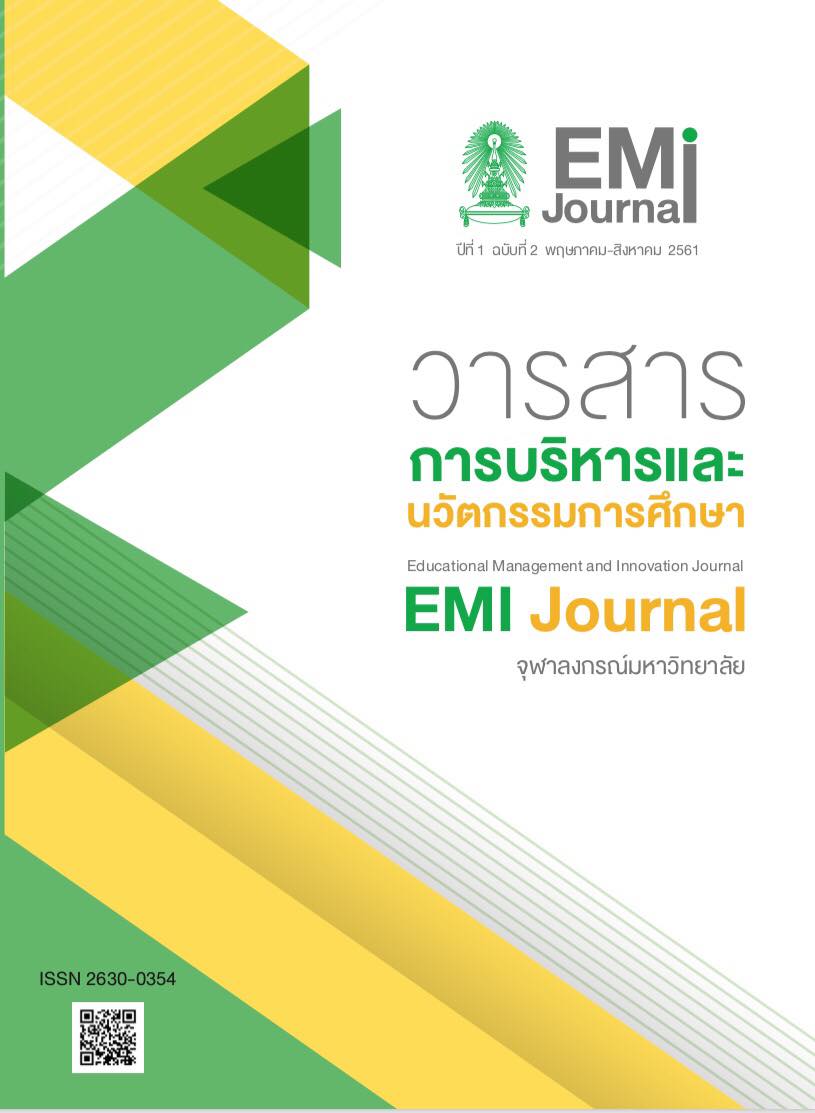การบริหารวิชาการตามแนวคิดการเรียนรู้แบบบูรณาการเนื้อหากับภาษา กรณีศึกษาในเอเชีย; ACADEMIC MANAGEMENT ACCORDING TO CLIL: CASE STUDIES IN ASIA
คำสำคัญ:
การบริหารวิชาการ, การเรียนรู้แบบบูรณาการเนื้อหากับภาษา, Academic Management, CLIL Approachบทคัดย่อ
วัตถุประสงค์ในการวิจัยครั้งนี้เพื่อ 1) ศึกษาการบริหารวิชาการตามแนวคิดการเรียนรู้แบบบูรณาการเนื้อหากับภาษา กรณีศึกษาในเอเชีย 2) ศึกษากลยุทธ์การบริหารวิชาการตามแนวคิดการเรียนรู้แบบบูรณาการเนื้อหากับภาษา กรณีศึกษาในเอเชีย ใช้ระเบียบวิธีวิจัยเชิงคุณภาพโดยใช้การวิจัยเอกสารจากแหล่งข้อมูลเอกสารขั้นปฐมภูมิ ได้แก่ งานวิจัยเกี่ยวกับการนำแนวคิดการเรียนรู้แบบบูรณาการเนื้อหากับภาษาไปใช้ในโรงเรียนมัธยมศึกษาในเอเชีย และเอกสารขั้นทุติยภูมิ ได้แก่ หนังสือ เอกสาร สื่ออิเล็กทรอนิกส์ที่มีเนื้อหาเกี่ยวกับการจัดการเรียนรู้ตามแนวคิดการเรียนรู้แบบบูรณาการเนื้อหากับภาษาในโรงเรียนมัธยมศึกษาในเอเชีย ใช้วิธีวิเคราะห์ข้อมูลเชิงพรรณนา ผลการวิจัยพบว่า 1) การบริหารวิชาการตามแนวคิดการเรียนรู้แบบบูรณาการเนื้อหากับภาษา กรณีศึกษาในเอเชียอยู่ในระยะทดลองนำร่องดำเนินการในแนวทางต่างที่ต้องใช้เวลาในการหาแนวทางการจัดการเรียนรู้ที่เหมาะสมกับบริบทอย่างมีประสิทธิภาพและประสิทธิผลในการพัฒนานักเรียนให้สู่เป้าหมายการเรียนรู้ทั้งด้านเนื้อหาและภาษาอังกฤษ 2) กลยุทธ์การบริหารวิชาการตามแนวคิดการเรียนรู้แบบบูรณาการเนื้อหากับภาษา กรณีศึกษาในเอเชีย มี 3 กลยุทธ์หลัก ดังนี้ (1) มุ่งพัฒนากระบวนการเรียนรู้ของนักเรียนตามแนวคิดการเรียนรู้แบบบูรณาการเนื้อหากับภาษา (2) ส่งเสริมคุณภาพการวัดและประเมินผลนักเรียนตามแนวคิดการเรียนรู้แบบบูรณาการเนื้อหากับภาษา และ (3) ปรับปรุงหลักสูตรสถานศึกษาตามแนวคิดการเรียนรู้แบบบูรณาการเนื้อหากับภาษา และมีข้อเสนอแนะ เพื่อพัฒนากระบวนการเรียนรู้ของนักเรียนคือการพัฒนาครูผู้สอนให้มีความรู้ความสามารถในการใช้ภาษาอังกฤษในการสื่อสาร การจัดการเรียนรู้ในรูปแบบต่าง ๆ รวมถึงการพัฒนาและใช้สื่อการเรียนรู้ตามแนวคิดการเรียนรู้แบบบูรณาการเนื้อหากับภาษา และผู้มีส่วนได้ส่วนเสียต้องมีความเชื่อในแนวเดียวกันและร่วมมือกันจัดการและสนับสนุนการดำเนินการทั้ง 3 กลยุทธ์ให้ประสบความสำเร็จ
ACADEMIC MANAGEMENT ACCORDING TO CLIL: CASE STUDIES IN ASIA
The research objectives were to: 1) study academic management according to CLIL in Asia; 2) study academic management strategies according to CLIL. The paper applied the qualitative methodology using documentary analysis. The data were analyzed by descriptive statistics. The study found that: 1) academic management according to CLIL in Asia was the pilot studies conducted to try to create suitable and effective CLIL models. 2) The academic management strategies consisted of 3 main strategies: (1) Developing students’ learning process according to CLIL; (2) Enhancing the effectiveness of measurement and evaluation
according to CLIL; (3) Improving the school curriculum according to CLIL. In addition, it suggests that in order to develop students’ learning process, teacher training in communicative English must be provided. Besides, Stakeholders’ belief and support were needed in order to successfully implement the 3 strategies.
Downloads
เอกสารอ้างอิง
ชูขวัญ รัตนพิทักษ์ธาดา. (2559). กลยุทธ์การบริหารวิชาการตามแนวคิดการเรียนรู้แบบบูรณาการเนื้อหากับภาษาและสมรรถนะทางภาษาอังกฤษของนักเรียนมัธยมศึกษา. (วิทยานิพนธ์ปริญญาดุษฎีบัณฑิต, สาขาวิชาบริหารการศึกษา ภาควิชานโยบายการจัดการและความเป็นผู้นำทางการศึกษา คณะครุศาสตร์ จุฬาลงกรณ์มหาวิทยาลัย).
เสาวภาคย์ ศรีโยธา. (2555). ปัญหาการเรียนภาษาอังกฤษระดับชั้นมัธยมศึกษาปีที่ 3 ในโรงเรียนขยายโอกาส สังกัดสำนักงานเขตพื้นที่การศึกษาประถมศึกษาพัทลุง เขต 1. (สารนิพนธ์ปริญญามหาบัณฑิต, คณะศิลปศาสตร์ สาขาวิชาการสอนภาษาอังกฤษเป็นภาษานานาชาติ มหาวิทยาลัยสงขลานครินทร์).
Ball, P. (2009). Does CLIL work?. In D. Hill, & P. Alan (Eds.), The best of both worlds?: International perspectives on CLIL. Norwich: Norwich Institute for Language Education.
Banegas, D. L. (2012). Integrated Contentand Language in English Language Teaching In Secondary Education: Models Benefits and Challenges [Online]. Retrieved from https://www.Academia.edu./1793825/ integrated _content and _language _in _englishlanguage _teaching _in _secondary _education _models _benefits _and _challenges
Bernabé, MaríaMoliner. (2013). The Effects of CLIL from the Perspective of In-service Teachers in Salamanca [Online]. Retrieved from www.exedrajournal.com
Chen, Fay. (2017). English Teachers’ Perspective on Implementing English-taught Program in Tainan, Taiwean. Retrieved from https://www.researchgate.net/publication/325120614_English_teachers%27_perspectives_on_implementing_English- taught_programs_in_Tainan_City_Taiwan
Coyle, D. (2005). Planning Tools for Teachers. The University of Nottingham: School of Education.
Coyle, D., Holmes, D., & King, L. (2009). Towards an integrated curriculum - CLIL national statement and guidelines. London, England: The Languages Company.
Coyle, D., Hood, P., & Marsh, D. (2010). CLIL - Content and Language Integrated Learning. Cambridge: Cambridge University Press.
Katsuaki, Okihara. (2014). The Background and Basic Assumptions of CLIL [Online]. Retrieved from https://notredame.repo.nii.ac.jp/?action=repository_action...item...
Kelly , K. P. (2014). Ingredients for successful CLIL [Online]. Retrieved from https://www.academia.edu/6361911/Ingredients_for_successful_CLIL
Loannou-Georgiou, S., & Pavlou, P. (2011). Guidelines for CLIL Implementation in Primary and Pre-Primary Education [Online]. Retrieved from http://www.schools.ac.cy/klimakio/Themata/Anglika/teaching material/clil /guidelinesforclilimplementation1.pdf [2015, November 25]
Lasagabaster, D. (2008). Foreign Language Competence in Content and Language Integrated Courses. The Open Applied Linguistics Journal, 1, 31-42.
Leone, A. R. (2015). Outlooks in Italy: CLIL as Language Education Policy [Online]. Retrieved from http://repository.upenn.edu/wpel/vol30/iss1/3/Leung, C. P. (2013). Content and language integrated learning: perceptions of teachers
and students in a Hong Kong secondary school [Online]. Retrieved from http://hub.hku.hk/bitstream/10722 /193541/1/FullText.pdf?accept=1
Prasongporn, P. (2009). CLIL in Thailand: Challenges and Possibilities. Paper presented at the first Access English EBE Symposium, Jakarta, Indonesia.
Villavicencio, A., & Grayman, J. K. (2012). Learning from “Turnaround” Middle Schools: Strategies for Success [Online]. Retrieved from http://steinhardt.nyu.edu/scmsAdmin/media/users/jnw216/RANYCS/WebDocs/RANYCS-MiddleSchoolTurnaround-ExecSummary-20120214.pdf
Wei, R., & Feng, J. (2015). Implementing CLIL for young learners in an EFL context beyond Europe [Online]. Retrieved from http://journals.cambridge.org
Yin, Chung Leung. (2013). Content and Language Integrated Learning: Perceptions of Teachers and Students in a Hong Kong Secondary School [Online]. Retrieved from
http://hub.hku.hk/handle/10722/193541



